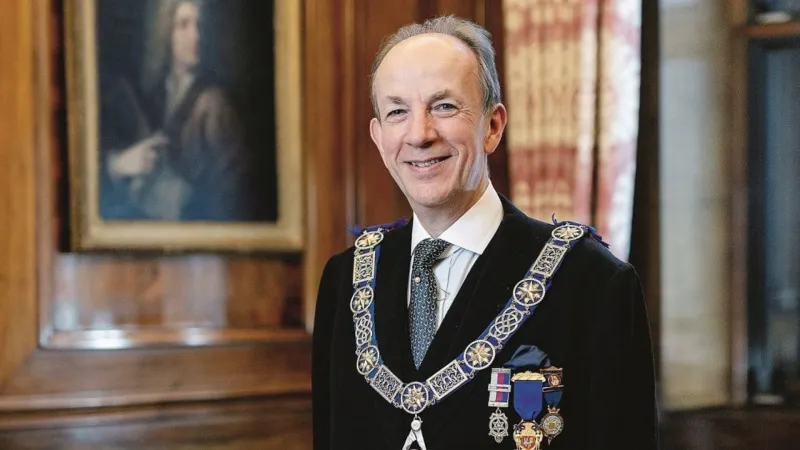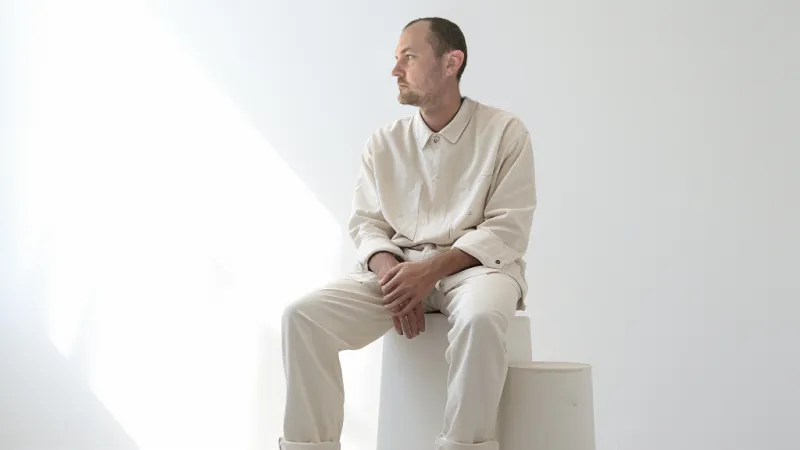Thomas Dunckerley was born on 23rd October 1724. During his very active life, he was to become an extraordinary and legendary figure in Freemasonry throughout the second half of the eighteenth century.

His mother’s marriage to a Mr Dunckerley was one of convenience as she had fallen pregnant to an un-named person of some importance. However, the marriage was short-lived, for her husband soon became aware of the identity of the real father and whether he could not cope with it, or he just gave up this organised sham, we shall never know. The father was in fact no less than the Prince of Wales, the natural son of King George II. Thomas revealed this to the world in his own handwriting, a document setting out all the facts which his executors published in the Freemasons’ Magazine in 1796, a few months after his death. The royal family had clearly made a financial provision for the mother and her son, as well as the occupancy of a grace and favour residence in Somerset House. Thomas was later granted a pension of £200 a year in quarterly instalments from none less than, the Secret Service Account!
When he left school, he was apprenticed as a barber, but finding he was not suited to that he soon ran away to sea and joined the Navy. He became a gunner and, in the mid 1740’s, was appointed the Schoolmaster aboard HMS Edinburgh, before becoming the Gunnery Officer on the sloop, Fortune. During the following years he saw service aboard a number of ships including HMS Vanguard and HMS Prince. He crossed and re-crossed the Atlantic many times and on Vanguard, where he was the Master Gunner, he was present at the battle for Quebec in support of General Wolfe and his army when they scaled the Heights of Abraham and overcame the French forces under General Montcalm.

Often, when Dunckerley’s ship docked at home or abroad, he became aware that many of his fellow Officers went ashore to attend Masonic Lodges and, as far as it is known, it was this that sparked his initial interest in Freemasonry. On 10th January 1754, when he was 29 years old and serving aboard HMS Tyger, he was Initiated into the Three Tuns Lodge No.31, in Portsmouth, whose members were mainly naval and military officers, augmented by successful men of business and the professions. On this day, he was not only Initiated, but also Passed and Raised; an unsurprising fact in those days when a Naval Officer had no idea when next he would return to port and his Mother Lodge. In 1788, the Three Tuns became the Lodge of Antiquity No.31 and with this name it survived until 1838.
By the 1750’s he had married and set up his home in Plymouth. He soon discovered that Masonry had prospered there too and joined the Pope’s Head Tavern Lodge No.134, and the Masons’ Arms Tavern Lodge No.67. In time he not only served as Worshipful Master of each of them, but was also very active in the Royal Arch.

However, his Naval service often took him far away to the North American seaboard for long periods where he attended Lodges with Brethren from both the Army and the Navy. We should remember that this was in that part of the 18th century when the people of the American colonies were becoming quite rebellious. But he did not merely attend Lodges. Such was his Masonic standing at home and only six years after his Initiation, Grand Lodge had given him written authority 'to inspect the Craft wherever he might go'. After attending his mother’s funeral in 1760, he returned to sea bearing a Warrant to hold a Lodge and make Masons on board HMS Vanguard. This is thought to be the first Lodge ever to be held on board ship whilst at sea. At Quebec in June of that same year, Dunckerley had installed the Honourable Simon Frazier, Colonel of the 78th Highland Regiment as Provincial Grand Master of Canada. In addition to HMS Vanguard, he also formed Lodges on board HMS Prince and HMS Guadeloupe.
The Vanguard Lodge came ashore in 1768 to become the London Lodge No.108, meeting today at Mark Masons’ Hall in St. James’ Street, London. Dunckerley was its first Worshipful Master, and the Lodge met first at The Queen of Bohemia’s Head, before moving to a room in the first London Coffee House on Ludgate Hill. Interestingly, the Minute Book of this Lodge records on 7th January 1769, that Rigge was elected Worshipful Master and Installed by Dunckerley himself. It also records, 'The Brethren present were unanimously of the opinion that the company would be better entertained with a few promiscuous songs from the Brothers than by any lecture or further proceedings in Masonry. Wherefore the Lodge was closed without such lecture'.
On the 22nd May 1762, Dunckerley was granted a Warrant that enabled him to form a Lodge aboard HMS Prince. This, when amalgamated with the Old Horn Lodge, one of the founders of Grand Lodge, subsequently became the Royal Somerset House and Inverness Lodge No.4, meeting today at Freemasons’ Hall, Great Queen Street.
One may only imagine the difficulties encountered by Dunckerley and his fellow Brothers when performing Masonic ceremonies aboard one of His Majesties fighting ships whilst on the high seas. Not only would the members have the confines of the ship to cope with where every word or noise could be overheard, but imagine the living conditions and the rolling and heaving of the vessel as well. Spaces to hold the meeting were small, so little perambulation could have taken place, the importance of the Tyler or outer guard can well be imagined. In fact, a modern-day script writer could well set the stage for a hilarious Monty Python episode. Oh no, not the one with a drunken sailor or an ex-parrot! The thought of 'up she rises' in a Third Degree conjures all sorts of scenes.
After leaving the Navy in 1764, Dunckerley moved from Plymouth and was living back in Somerset House in an apartment made available to him by the Duke of Devonshire. He never relented from his Masonic interests and was kept busy composing rituals for most, if not all of the Degrees regularly practised.
His vast knowledge, coupled with his tremendous enthusiasm and dedication, well qualified him to be appointed on the 28th February 1767, the first Provincial Grand Master over the Province of Hampshire, or the County of Southampton as it was then known. Additionally, in 1772 he was appointed the first Provincial Grand Master for the Isle of Wight.
One of the Lodges in the Province of Hampshire was the Ringwood Lodge, today known as the Lodge of Unity No.132. Although the Lodge has an engraving of a portrait of Dunckerley, the original by Philip Van Dyke hangs in the Lodge of Amity No.137, which he frequently visited. In September 1783, the Lodge Minutes record the payment of five guineas to him for his fine portrait, with the addition of 3/6d as payment for the frame.
In 1770, acting as the Provincial Grand Master of Hampshire, Dunckerley consecrated his first Lodge at the New Inn, Christchurch. It now meets at Knoll Road as the Lodge of Hengist No.195. By 1790, he was simultaneously Provincial Grand Master of no less than nine Provinces. These included, Hampshire, Isle of Wight (then a separate Province), Essex, Dorset, Wiltshire, Somerset, Gloucestershire, Bristol, and Herefordshire. Being the man he was, he was no mere figurehead and saw it as his duty, and his pleasure too, to visit his Lodges frequently and to take a full part in everything. In addition, he held high office in Chapter where he was Grand Superintendent of eighteen counties stretching from Durham to Cornwall, and he was also active in many other Degrees. Imagine his life: the organising and administration, the travelling, the writing of all his correspondence, of which much survives. And all this was before the invention of the railways, before the laying down of modern roads and motorways, or the convenience of the telephone or email. His sole means of transport was the horse; either astride one or, more than often, in a carriage drawn by one.
It was in the year of 1777, when Dunckerley was appointed 'Superintendent of the Lodges' in the County of Dorset. He had to wait until the 23rd March 1783 before the Patent was issued designating him Provincial Grand Master, but that little detail did not get in the way of him presiding over meetings of the Provincial Grand Lodge. The first of these meetings was on St John’s Day, 24th June 1780, and was held under the banner of the Lodge of Amity in Poole. The Provincial Minute Book records that Provincial Grand Lodge was held in the morning when all the Officers were appointed. Then the Brethren went through the streets of the town in procession to the Parish Church of St. James for Divine Service. This was followed by a dinner at midday in the Guildhall, and as records inform us 'where mirth, good humour and jollity, as well as a number of excellent good songs sung by Thomas Dunckerley concluded this Provincial Grand Lodge'.
Eventually, the strains of his long and very active life began to wear him down as he reached his seventieth year. From 1792 onwards, correspondence frequently refers to the pain he suffered from gout and the general deterioration in his health.
In the Spring of 1795, Dunckerley and his wife left Hampton Court, where they were then living, and moved into their home at Portsmouth. He was 71. It was there that he died on 21st November of that year and was buried in St. Mary’s churchyard, Portsea. It seems so tragic to tell you that a century later during rebuilding of the church, many of the gravestones were removed and were neither recorded at the time nor replaced after the works were completed. So, today, sadly it is not known exactly where the remains of one of the greatest Masons ever to have lived are interred.
Thomas Dunckerley certainly had stood out well in the eighteenth century crowd. From an ignominious start in life he showed so many of the virtues and the qualities that we so admire today. Initiative, determination, stamina, dynamism, zeal, integrity, Christian charity and, not least, love of his fellow mankind and especially, his fellow Brethren.
Research by David Smith
Lodge of St Cuthberga 622


